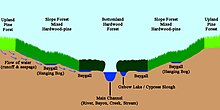Bayhead
A bayhead or baygall is a specific type of wetland or swamp habitat.[1][2] The name baygall is derived from sweetbay magnolia (Magnolia virginiana) and sweet gallberry holly (Ilex coriacea).[3] Baygalls are recognized as a discrete ecosystem by ecologist and the swamps have been described as "distinct wetland communities in the Natural Communities of Louisiana".[1][2] Baygall swamps are most often found in the low laying margins of floodplains and bottomlands with little or poor drainage to the main creek, bayou, or river channel. Baygall or bayhead swamps found on slopes and hillsides are sometimes referred to as a forest seep or hanging bogs. Hanging bogs are typically found in hardwood-pine forests. Most baygall swamps are semi-permanently saturated, or flooded.[1][2][4][5]

_Jack_Gore_Baygall_Unit%2C_Hardin_Co._TX%3B_6_Nov_2019.jpg)
The characteristics of a bayhead swamp are mostly broad, shallow drains, which can be found near margins of bottomlands and floodplains with little or no drainage. They most often receive a slow, but steady supply of water from seepage at the base of slopes and bluffs.[1] Baygalls are relatively shallow wetlands, ranging from wet and saturated soils and leaf litter, to a few inches of stagnate or very slowly moving water, although some may occasionally be deeper depending on topography and rainfall. Most are also under closed or nearly closed canopies.[3][1][2] Occasionally, larger and deeper baygalls may have open water at the center with floating vegetation such as the fragrant water-lily (Nymphaea odorata).[3]
High acidity levels distinguish baygalls from other wetlands and they often support plant communities that are distinct form adjacent areas.[1][3] Sphagnum is often associated with baygalls. Sometimes referred to as acid bog baygalls, baygalls typically have very lowpH levels. Levels as low as 4.5 are not uncommon in the baygalls of the Big Thicket region of Southeast Texas, USA. The acidic waters that drain from baygalls can contribute significantly to blackwater rivers and creeks in the bottomlands.[1] A baygall may be no more than a small pool or they can be a mile across.[3][1][2] The Jack Gore Baygall Unit of the Big Thicket National Preserve at 12 square miles, is said to be is the largest in the world.[6]
Flora
Baygalls are typically found in densely forested areas. Over-story trees associated with baygalls include baldcypress (Taxodium distichum), swamp tupelo or swamp blackgum (Nyssa biflora), red maple (Acer rubrum), green ash (Fraxinus pennsylvanica), laurel oak (Quercus laurifolia), water oak (Quercus nigra), sweetgum (Liquidambar styraciflua), and sweetbay (Magnolia virginiana). Longleaf pine (Pinus palustris) are usually associated with hanging bogs or forest seeps.[1][2][3][4]
Understory species include smooth or hazel alder (Alnus serrulata), swamp titi or leatherwood (Cyrilla racemiflora), sweet gallberry (Ilex coriacea), American holly (Ilex opaca), Virginia willow or sweetspire (Itea virginica), wax-myrtle (Morella cerifera), red bay (Persea borbonia), swamp redbay (Persea palustris), bamboo-vine (Smilax laurifolia), poison sumac (Toxicodendron vernix), possum-haw viburnum (Viburnum nudum), muscadine grape (Vitis rotundifolia).[1][2][3][4]
Ferns such as net-veined chain fern (Lorinseria [Woodwardia areolata] areolata), sensitive fern (Onoclea sensibilis), cinnamon fern (Osmunda cinnamomea), and royal fern (Osmunda regalis) may be found in the herbaceous layer. Several species of orchid (Orchidaceae) are also associated with baygalls.[1][2][3][4]
Species of conservation concern
The baygall swamps have around 20 animal species which are considered to be endangered or of conservation concern in various states and countries. [2]
|
Butterflies
Amphibians
Mammals
|
Birds
|
References
- Watson, Geraldine Ellis (2006) Big Thicket Plant Ecology: An Introduction, Third Edition (Temple Big Thicket Series #5). University of North Texas Press. 152 pp. ISBN 978-1574412147
- Natural Communities of Louisiana:Bayhead Swamp/Forested Seep. Louisiana Department of Wildlife and Fisheries. Retrieved 7 July 2020.
- Ajilvsgi, Geyata (1979) Wild Flowers of the Big Thicket: East Texas, and Western Louisiana. Texas A&M University Press. College Station, Texas 361 pp. ISBN 0-89096-064-X
- Texas Parks and Wildlife. Ecological Mapping systems of Texas: West Gulf Coastal Plain Seepage Swamp and Baygall Retrieved 7 July 2020
- Fiona Sunquist; Mel Sunquist; Les Beletsky (2008). Florida. Interlink Books. p. 19. ISBN 1566566517.
- Peacock, Howard (1994) Nature Lover's Guide to the Big Thicket. Texas A&M. University Press. College Station, Texas. 169 pp. ISBN 0-89096-589-7